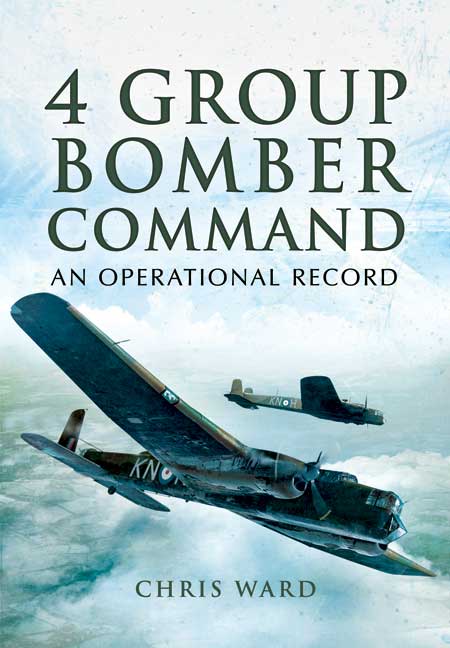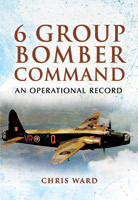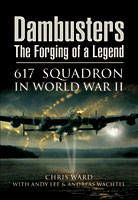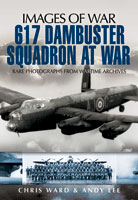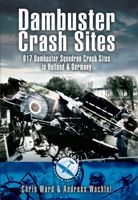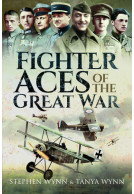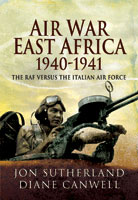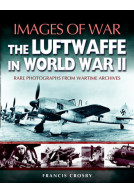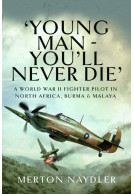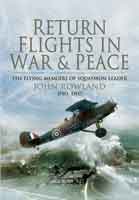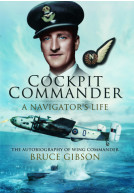4 Group Bomber Command (Hardback)
An Operational Record
Imprint: Pen & Sword Aviation
Pages: 290
ISBN: 9781848848849
Published: 5th November 2012
(click here for international delivery rates)
Need a currency converter? Check XE.com for live rates
| Other formats available - Buy the Hardback and get the eBook for free! | Price |
|---|---|
| 4 Group Bomber Command eBook (1.6 MB) Add to Basket | £6.99 |
During the immediate period before World War Two, the RAF modified its command structure to rationalise for rapid expansion. Bomber Command was divided into six operational groups, each flying the same type of aircraft, including Wellingtons, Sterlings, and Lancasters. Chris Ward presents us here with the history of 4 Group Bomber Command, having previously acquainted us with the histories of 3, 5, and 6 Group Bomber Commands in three highly acclaimed volumes, published by Pen and Sword. He continues with characteristic ease, quality of research, and narrative pace, to present us with an operational record of the groups activities during a particularly dramatic period of aviation history.
This book contains individual squadron statistics, their commanding officers, stations and aircraft losses. It provides a detailed reference for one of the RAF's most important operational groups.
A solidly researched book giving us masses of information about the squadrons and aircraft of 4 Group of Bomber Command. The author gives us a concise but engaging history of operations before dissecting individual squadron efforts with a look at the service time of commanding officers, stats on achievement or otherwise and then a long and detailed list of individual aircraft histories. ... The photograph section is superb and includes a wide range of images of aircrew of all ranks and their aircraft.
War History Online
A detailed reference work on activities of the Squadron during World War II, including photos some never before published.
Pennant Magazine
During World War 2 the RAF’s 4 Group in Bomber Command played a vital and critical role in the aerial offensive against Germany. This interesting book details their heroic operations and it gives plenty of supporting data on the aircraft and squadrons of this Group.
Military Archive Research
This book has outstanding chapters on squadron histories, their commanding officers, the stations they operated from and the losses in terms of aircraft. It is a highly useful reference work on 4 Group and its history.
The author has essentially split this reference book into two sections. The first section deals with operations. This data is effectively a monthly / quarterly / yearly diary of operations and these entries are highly detailed. The second section is a history of each squadron which was part of 4 Group. The squadron entries normally consist of an introduction to the squadron, its operational code letters, is stations and dates, its commanding officers and dates, aircraft and aircraft types with dates, operational statistics (such as losses with respect to operations) and brief details of all known aircraft that operated with the squadron.
If the history of the bombing campaign against Nazi Germany interests you and you wish to know more about Bomber Command’s constituent Groups then this book is the book to have on 4 Group.
The author’s research skills and his efforts in collating the data for this book are outstanding and he has done the memory of these brave flyers true justice. He deserves a “well done” and I would expect that his sister volumes on the other Groups will be of a similar very high standard.
About Chris Ward
Chris Ward has been writing about RAF Bomber Command in WW11 since the mid nineties. He began with his highly successful Bomber Command Squadron Profile series of spiral-bound publications. It was during this period that Andreas Wachtel contacted Chris for information for a book he was writing, and the two became the closest of friends, to the extent that they regard each other as family. When Chris began working on his first major work, Dambusters, The Definitive History, which was published by Red Kite in 2003, Andreas took on the initial research in Germany and Holland. In this way Chris and Andreas made available to others the Dams raid crash sites of Maudslay and Barlow, which had never previously been identified, and they also publicised the scene of Astell’s crash, which is maintained by a local historian. Through this research Chris was able to correct long-held misconceptions about the circumstances of the crashes.
Chris was the first to research in depth the events of the Dortmund-Ems Canal disaster, which took place four months after the dams. He and Andreas discovered the crash sites of Holden, Allsebrook, Wilson and Divall, which had never previously been identified, let alone documented and surveyed. In 2013 a number of historians in the German town of Nordhorn released a book about the air war as experienced by the local community of Bentheim on Germany’s border with Holland. The inspiration for this book, which is a massive tome involving hundreds of hours of work, was Chris’s account of Holden’s crash on the farm of the Hood family, which resulted not only in the deaths of the eight-man Lancaster crew, including four members of Guy Gibson’s Dams crew, but also Frau Hood. 70 years to the day after this tragedy, on Sunday 15th September 2013, Chris and Andreas were guests of honour at a civic reception in Nordhorn to release the book. There was also a ceremony at the crash site beside the Hood farmyard, attended by the whole local Hood family, local dignitaries, the authors of the book and many interested spectators.
Another Chris Ward first was his enquiry into the events on the German side during the final attack by 617 and 9 Squadrons on the Tirpitz in a Norwegian fjord in November 1944. Kurt Schulze, who was a pilot on the nearby fighter airfield at Bardufoss at the time, sent Chris a copy of the transcripts of the German Courts Martial, which took place six weeks after the loss of Tirpitz to apportion blame. Chris translated them, and devoted an entire chapter in his original book and the P&S update to the reasons behind the German failure to intercept the approaching Lancaster force.
Chris has since worked on a series of books for P&S detailing the histories of the bomber groups. Those on 3, 4, 5 and 6 Groups have just been joined by his latest, 1 Group. He is currently working on an updated series of Bomber Command Squadron Profiles, which P&S have undertaken to publish in hardback.







